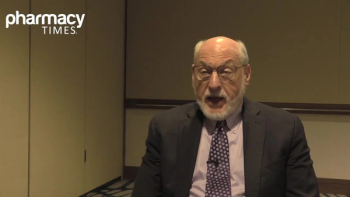
Pharmacy Practice in Focus: Oncology
- October 2021
- Volume 3
- Issue 5
Updates in Prostate Cancer Treatment
New therapeutics for prostate cancer must continue to be assessed for comparative safety and efficacy, as well as accessibility for patients.
Prostate cancer (PCa) accounts for 26% of new cancer cases—the most common cancer diagnosis in men—and 11% of all cancer-related deaths, making it the second most common cause.1 PCa diagnosis has a median age of 67 years.2 Nonmodifiable risk factors include age (55 years or older), race (due to the high relative incidence in Black men), and genetics (such as mutations in DNA repair genes like BRCA1/2 or PCa-specific risk genes like HOXB13).3
However, the relative impact of modifiable risk factors, such as obesity and smoking cigarettes, remains controversial.3 Although 5α-reductase inhibitors, selenium, and vitamin E are among the agents explored for PCa prevention, outcomes have been mixed and none are FDA approved for this indication.4-7
Most cases of PCa are detected at an early stage through prostate-specific antigen (PSA) testing and digital rectal examinations, with 70% of new diagnoses presenting localized disease and 5% with distant metastases.2,8-10 Although multiple screening recommendations do exist, most take into consideration age, life expectancy, and family history of any cancer.8-10
Patients with early-stage PCa are often asymptomatic.3 Common symptoms, when present, include urinary hesitancy, incomplete voiding, and hematuria.3 Additionally, bone, lymph nodes, liver, and thorax are common sites of distant metastases.3,11
PCa arises from excess activation of the androgen receptor (AR) signaling pathway. The serine protease gene PSA, produced by both normal and abnormal cells in the prostate gland, localizes to nuclei of androgen-stimulated PCa cells and impacts transcription and translation within the AR pathway3; normal PSA values range from 0 to 4.0 ng/mL.
Elevated PSA is a component of diagnosis for PCa and is trended to monitor response to treatment and disease progression. However, PSA may also be elevated by non-PCa causes, such as benign prostatic hyperplasia, infections, trauma, and ejaculation.3
The risk groups for PCa are based on factors such as PSA, Gleason grade (higher scores indicate abnormal cribriform gland formation), tumor size (TNM staging), and prostate biopsy or pelvic/ abdominal imaging; however, both risk group and life expectancy lead to the determination of eligibility for less aggressive interventions.12 Definitive treat- ment for localized PCa includes active surveillance, external beam radiation therapy, brachytherapy, and radical prostatectomy.3,12
One aim of systemic therapy in PCa is to reduce testosterone levels and receptor binding, which leads to dampening growth/proliferation of prostate basal/ luminal cells. Castrate levels of testosterone (< 50 ng/dL) may be achieved surgically with bilateral orchiectomy, or medically with androgen deprivation therapy (ADT).12,13
For lower-risk patients with longer life expectancies, ADT is utilized adjuvantly.11 In contrast, ADT is initial therapy—commonly with radiation—for unfavorable intermediate-risk, high-risk, and very high-risk localized PCa, as well as PCa with metas- tases to regional lymph nodes or distant sites.12
ADT used for PCa treatment includes luteinizing hormone-releasing hormone (LHRH) agonists and antagonists. For advanced PCa, the FDA-approved LHRH agonists include goserelin and leuprolide.14,15
Tumor flare (eg, hot flashes, bone pain) due to initial testosterone surge with agonists can be prevented in patients with bone metastases by administering a first-generation antiandrogen initially from 7 to 10 days prior to initiating LHRH agonists and continued through the end of LHRH agonist therapy.16 Notably, disease progression during tumor flare is unlikely.17
Compared with agonists, LHRH antagonists result in more immediate decreases of testosterone; these agents are administered without an antiandrogen.18 Both intravenous (degarelix) and more recently, oral (relugolix) LHRH antagonists are FDA approved.19,20
In the multinational, randomized, open-label, phase 3 HERO trial (NCT03085095), investigators compared relugolix and leuprolide acetate for the treatment of advanced PCa.20 Among the 622 patients receiving relugolix and 308 receiving leuprolide, 50.2% of patients had biochemical recurrence after definitive treatment. For sustained castration rate (cumulative probability of testosterone suppression to < 50 ng/dL from day 29 through 48 weeks), relugolix attained a rate of 96.7% (95% CI, 94.9-97.9), which was superior to leuprolide at 88.8% (95% CI, 86.4-91.8) based on the lower boundary of the 95% CI for the difference between the 2 arms.
The rate of testosterone suppression at less than 20 ng/dL on day 15 was also higher with relugolix (78.4% vs 1.0%). Testosterone at less than 20 ng/dL with ADT has been associated with improved survival and time to disease progression when compared with testos- terone at less than 50 ng/dL.
During the trial, the most common adverse event (AE) was any-grade hot flash, with similar incidence between cohorts. Major cardiovascular events occurred among all patients at 2.9% for relugolix (95% CI, 1.7-4.5) and 6.2% for leuprolide (95% CI, 3.8-9.5); for patients with cardiovascular history, a cardiovascular event during treatment was 4.8 times more likely with leuprolide.
For metastatic castrate-sensitive prostate cancer (CSPC), ADT may be combined with other therapies, including abiraterone (if high-risk CSPC) with or without radiation,21 docetaxel (if high-volume metastases and ADT-naive), apalutamide, and enzalutamide.12,22-25
On average, medical castration is effective for 2 to 3 years before clinical, radiographic, or biochemical progression, despite castrate testosterone levels.3,12 At this point, the disease is termed castration-resistant PCa (CRPC). Because of diverse mechanisms of resistance, ADT should be continued throughout CRPC as tolerated to target those PCa cells that lack a means of evading AR-induced apoptosis.3,12
For nonmetastatic CRPC, second-generation antiandrogens apalutamide, darolutamide, or enzalutamide may be combined with ADT.12,26-28 Differing toxicity profiles help drive treatment selection.
For metastatic CRPC (mCRPC), first-line options include abiraterone (conventional or micronized) or docetaxel.12,29-31 Cabazitaxel is an alternative for docetaxel, particularly if peripheral neuropathy is a concern.32-33 Cabazitaxel can be combined with carboplatin if disease is aggressive (eg, bulky disease or high lactate dehydrogenase) or characterized by unfavorable genomics (eg, TP53 or PTEN).34 Addi- tionally, mitoxantrone is used in subsequent lines of therapy due to inferior overall survival (OS) vs docetaxel or cabazitaxel.30,35 Another first-line option for hormone therapy-naive mCRPC is enzalutamide alone or with ADT.36-38
Therapies with more niche indications include radium-223, which is reserved for symptomatic mCRPC (bone metastases), and sipuleucel-T, which is limited to asymptomatic, indolent mCRPC, excluding visceral metastases.39,40
For mCRPC progressed on hormone therapy and/ or docetaxel, the PD-1 inhibitor pembrolizumab may be used for known deficient mismatch repair (dMMR) gene mutations or microsatellite instability-high (MSI-H) cancer cells.41 Non-dMMR or MSI-H populations are included in ongoing pembrolizumab studies as monotherapy or with enzalutamide, olaparib, and docetaxel.42-45
The PARP inhibitor olaparib is FDA approved for mCRPC progressed on AR-directed therapy and known homologous recombination repair mutations. PROfound, a randomized, open-label, phase 3 trial (NCT02987543), demonstrated prolonged imaging- based median progression-free survival (mPFS) with olaparib (7.4 months for n = 162) vs choice of enzalutamide or abiraterone (3.6 months for n = 83; P < .001) in mCRPC with a deleterious germline/somatic alteration in BRCA1/2 or other DNA damage response and repair (DDR) gene.46 More mature data will be needed to finalize OS benefit of olaparib. Anemia was the most common AE at grade 3 or greater.
Rucaparib, in contrast, is FDA approved for mCRPC previously treated with both AR-directed and taxane therapies, and with known BRCA1/2 mutations (12% incidence in mCRPC). TRITON2, an international, open-label, phase 2 study (NCT02952534), found that rucaparib with concomitant LHRH agonist/antagonist or prior bilateral orchiectomy resulted in an overall response rate based on an independent radiology review of 43.5% (95% CI, 31.0%-56.7%) in 62 patients with a deleterious germline/somatic alteration in BRCA1/2 or other DDR gene and measurable disease.47 Additionally, PSA response rate was seen in 54.8% (95% CI, 45.2-64.1) of enrolled patients, including those without measurable disease. Anemia/decreased hemoglobin was the most common grade 3 or greater AE.
Prostate-specific membrane antigen (PSMA) expression is elevated in CRPC, making room for a radioligand in heavily pretreated mCRPC with PSMA positivity. The prospective, open-label, randomized, international, phase 3 VISION trial (NCT03511664) evaluated the impact of adding 177Lu-PSMA-617 to standard care in mCRPC previously treated with greater than or equal to 1 AR-pathway inhibitor and 1 to 2 taxanes, although FDA-approved chemotherapy, immunotherapy, and radium-223 were excluded.
During the VISION trial, investigators randomized 551 men to 177Lu-PSMA-617 and 280 to only standard of care.48 Primary end points of imaging-based mPFS (8.7 vs 3.4 months; P < .001) and median OS (15.3 vs 11.3 months; P < .001) were prolonged with addition of this radioligand, though in context of a high incidence of withdrawal in the control group. The most common AEs observed with the addition of 177Lu-PSMA-617 were all-grade and high-grade fatigue, dry mouth, nausea, and anemia.
Although ADT continues to be a cornerstone of PCa treatment, new therapeutics—alone and with existing first-line agents—will need to be assessed for comparative safety and efficacy, as well as accessibility for patients. Additionally, preferred regimens may continue to shift as data emerge, particularly in the mCRPC setting.
REFERENCES
[1:47 PM] Aislinn Antrim
References
- Siegel RL, Miller KD, Fuchs HE, Jemal A. Cancer statistics, 2021. CA Cancer J Clin. 2021;71(1):7-33. doi:10.3322/caac.21654
- Cancer stat facts: prostate cancer. National Cancer Institute Surveillance, Epidemiology, and End Results Program. Accessed June 1, 2021.
https://seer.cancer.gov/statfacts/html/prost.html - Rebello RJ, Oing C, Knudsen KE, et al. Prostate cancer. Nat Rev Dis Primers. 2021;7(1):9. doi:10.1038/s41572-020-00243-0
- Klein EA, Thompson IM Jr, Tangen CM, et al. Vitamin E and the risk of prostate cancer: the Selenium and Vitamin E Cancer Prevention Trial (SELECT). JAMA. 2011;306(14):1549-1556. doi:10.1001/jama.2011.1437
- Sayehmiri K, Azami M, Mohammadi Y, Soleymani A, Tardeh Z. The association between selenium and prostate cancer: a systematic review and meta-analysis. Asian Pac J Cancer Prev. 2018;19(6):1431-1437. doi:10.22034/APJCP.2018.19.6.1431
- Thompson IM, Goodman PJ, Tangen CM, et al. The influence of finasteride on the development of prostate cancer. N Engl J Med. 2003;349(3):215-224. doi:10.1056/NEJMoa030660
- Andriole GL, Bostwick DG, Brawley OW, et al; REDUCE Study Group. Effect of dutasteride on the risk of prostate cancer. N Engl J Med. 2010;362(13):1192-1202. doi:10.1056/NEJMoa0908127
- Final recommendation statement, prostate cancer: screening. U.S. Preventive Services Task Force. May 8, 2018. Accessed May 22, 2021.
https://www.uspreventiveservicestaskforce.org/uspstf/recommendation/prostate-cancer-screening - Mohler JL, Antonarakis ES, Armstong AJ, et al. Prostate cancer, version 2.2019, NCCN Clinical Practice Guidelines in Oncology. J Natl Compr Canc Netw. 2019;17(5):479-505. doi:10.6004/jnccn.2019.0023
- Carter HB, Albertsen PC, Barry MJ, et al. Early detection of prostate cancer: AUA guideline. J Urol. 2013;190(2):419-426. doi:10.1016/j.juro.2013.04.119
- Gandaglia G, Abdollah F, Schiffmann J, et al. Distribution of metastatic sites in patients with prostate cancer: a population-based analysis. Prostate. 2014;74(2):210-216. doi:10.1002/pros.22742
- NCCN. Clinical Practice Guidelines in Oncology. Prostate cancer, version 2.2021. Accessed May 22, 2021.
https://www.nccn.org/professionals/physician_gls/pdf/prostate.pdf - Ozyigit G, Hurmuz P, Yuce D, Akyol F. Prognostic significance of castrate testosterone levels for patients with intermediate and high risk prostate cancer. World J Clin Oncol. 2019;10(8):283-292. doi:10.5306/wjco.v10.i8.283
- Eisenberger MA, Blumenstein BA, Crawford ED, et al. Bilateral orchiectomy with or without flutamide for metastatic prostate cancer. N Engl J Med. 1998;339(15):1036-1042. doi:10.1056/NEJM199810083391504
- Vogelzang NJ, Chodak GW, Soloway MS, et al. Goserelin versus orchiectomy in the treatment of advanced prostate cancer: final results of a randomized trial. Zoladex Prostate Study Group. Urology. 1995;46(2):220-226. doi:10.1016/s0090-4295(99)80197-6.
- Thompson IM. Flare associated with LHRH-agonist therapy. Rev Urol. 2001;3(suppl 3):S10-S14.
- Vis AN, van der Sluis TM, Al-Itejawi HHM, van Moorselaar RJA, Meuleman EJH. Risk of disease flare with LHRH agonist therapy in men with prostate cancer: myth or fact? Urol Oncol. 2015;33(1):7-15. doi:10.1016/j.urolonc.2014.04.016
- Bhatia S, Tykodi SS, Thompson JA. Treatment of metastatic melanoma: an overview. Oncology (Williston Park). 2009;23(6):488-496.
- Klotz L, Boccon-Gibod L, Shore ND, et al. The efficacy and safety of degarelix: a 12-month, comparative, randomized, open-label, parallel-group phase III study in patients with prostate cancer. BJU Int. 2008;102(11);1531-1538. doi:10.1111/j.1464-410X.2008.08183.x
- Shore ND, Saad F, Cookson MS, et al; HERO Study Investigators. Oral relugolix for androgen-deprivation therapy in advanced prostate cancer. N Engl J Med. 2020;382(23):2187-2196. doi:10.1056/NEJMoa2004325
- Fizazi K, Maldonado X, Foulon S, et al. A phase 3 trial with a 2×2 factorial design of abiraterone acetate plus prednisone and/or local radiotherapy in men with de novo metastatic castration-sensitive prostate cancer (mCSPC): first results of PEACE-1. J Clin Oncol. 2021;39(suppl 15):5000. doi:10.1200/JCO.2021.39.15_suppl.5000
- Fizazi K, Tran N, Fein L, et al. Abiraterone acetate plus prednisone in patients with newly diagnosed high-risk metastatic castration-sensitive prostate cancer (LATITUDE): final overall survival analysis of a randomised, double-blind, phase 3 trial. Lancet Oncol. 2019;20(5):686-700. doi:10.1016/S1470-2045(19)30082-8
- Parker CC, James ND, Brawley CD, et al; Systemic Therapy for Advanced or Metastatic Prostate Cancer: Evaluation of Drug Efficacy (STAMPEDE) investigators. Radiotherapy to the primary tumour for newly diagnosed, metastatic prostate cancer (STAMPEDE): a randomised controlled phase 3 trial. Lancet. 2018;392(10162):2353-2366. doi:10.1016/S0140-6736(18)32486-3
- Davis ID, Martin AJ, Stockler MR, et al. Enzalutamide with standard first-line therapy in metastatic prostate cancer. N Engl J Med. 2019;381(2):121-131. doi:10.1056/NEJMoa1903835
- Chi KN, Agarwal N, Bjartell A, et al. Apalutamide for metastatic, castration-sensitive prostate cancer. N Engl J Med. 2019;381(1):13-24. doi:10.1056/NEJMoa1903307
- Smith MR, Saad F, Chowdhury S, et al; SPARTAN Investigators. Apalutamide treatment and metastasis-free survival in prostate cancer. N Engl J Med. 2018;378(15):1408-1418. doi:10.1056/NEJMoa1715546
- Fizazi K, Shore N, Tammela TL, et al; ARAMIS Investigators. Darolutamide in nonmetastatic, castration-resistant prostate cancer. N Engl J Med. 2019;380(13):1235-1246. doi:10.1056/NEJMoa1815671
- Hussain M, Fizazi K, Saad F, et al. Enzalutamide in men with nonmetastatic, castration-resistant prostate cancer. N Engl J Med. 2018;378(26):2465-2474. doi:10.1056/nejmoa1800536
- De Bono JS, Logothetis CJ, Molina A, et al; COU-AA-301 Investigators. Abiraterone and increased survival in metastatic prostate cancer. N Engl J Med. 2011;364(21):1995-2005. doi:10.1056/nejmoa1014618
- Tannock IF, de Wit R, Berry WR, et al; TAX 327 Investigators. Docetaxel plus prednisone or mitoxantrone plus prednisone for advanced prostate cancer. N Engl J Med. 2004;351(15):1502-1512. doi:10.1056/NEJMoa040720
- Stein CA, Levin R, Given R, et al. Randomized phase 2 therapeutic equivalence study of abiraterone acetate fine particle formulation vs. originator abiraterone acetate in patients with metastatic castration-resistant prostate cancer: the STAAR study. Urol Oncol. 2018;36(2):81.e9-81.e16. doi:10.1016/j.urolonc.2017.10.018
- Eisenberger M, Hardy-Bessard AC, Kim CS, et al. Phase III study comparing a reduced dose of cabazitaxel (20 mg/m2) and the currently approved dose (25 mg/m2) in postdocetaxel patients with metastatic castration-resistant prostate cancer—PROSELICA. J Clin Oncol. 2017;35(28):3198-3206. doi:10.1200/JCO.2016.72.1076
- De Wit R, de Bono J, Sterberg CN, et al; CARD Investigators. Cabazitaxel versus abiraterone or enzalutamide in metastatic prostate cancer. N Engl J Med. 2019;381(26):2506-2518. doi:10.1056/NEJMoa1911206
- Corn PG, Heath EI, Zurita A, et al. Cabazitaxel plus carboplatin for the treatment of men with metastatic castration-resistant prostate cancers: a randomised, open-label, phase 1-2 trial. Lancet Oncol. 2019;20(10):1432-1443. doi:10.1016/S1470-2045(19)30408-5
- De Bono JS, Oudard S, Ozguroglu M, et al; TROPIC Investigators. Prednisone plus cabazitaxel or mitoxantrone for metastatic castration-resistant prostate cancer progressing after docetaxel treatment: a randomised open-label trial. Lancet. 2010;376(9747):1147-1154. doi:10.1016/S0140-6736(10)61389-X
- Scher HI, Fizazi K, Saad F, et al; AFFIRM Investigators. Increased survival with enzalutamide in prostate cancer after chemotherapy. N Engl J Med. 2012;367(13):1187-1197. doi:10.1056/NEJMoa1207506
- Beer TM, Armstrong AJ, Rathkopf DE, et al; PREVAIL Investigators. Enzalutamide in metastatic prostate cancer before chemotherapy. N Engl J Med. 2014;371(5);424-433. doi:10.1056/nejmoa1405095
- Armstrong AJ, Szmulewitz RZ, Petrylak DP, et al. ARCHES: A randomized, phase III study of androgen deprivation therapy with enzalutamide or placebo in men with metastatic hormone-sensitive prostate cancer. J Clin Oncol. 2019;37(32):2974-2986. doi:10.1200/JCO.19.00799
- Hoskin P, Sartor O, O’Sullivan JM, et al. Efficacy and safety of radium-223 dichloride in patients with castration-resistant prostate cancer and symptomatic bone metastases, with or without previous docetaxel use: a prespecified subgroup analysis from the randomised, double-blind, phase 3 ALSYMPCA trial. Lancet Oncol. 2014;15(12):1397-1406. doi:10.1016/S1470-2045(14)70474-7
- Kantoff PW, Higano CS, Shore ND, et al; IMPACT Study Investigators. Sipuleucel-T immunotherapy for castration-resistant prostate cancer. N Engl J Med. 2010;363(5):411-422. doi:10.1056/NEJMoa1001294
- Marcus L, Lemery SJ, Keegan P, Pazdur R. FDA approval summary: pembrolizumab for the treatment of microsatellite instability-high solid tumors. Clin Cancer Res. 2019;25(13):3753-3758. doi:10.1158/1078-0432.CCR-18-4070
- Antonarakis ES, Piulats JM, Gross-Goupil M, et al. Pembrolizumab for treatment-refractory metastatic castration-resistant prostate cancer: multicohort, open-label phase II KEYNOTE-199 study. J Clin Oncol. 2020;38(5):395-405. doi:10.1200/JCO.19.01638
- Graff JN, Liang LI, Kim J, Stenzl A. KEYNOTE-641: a phase III study of pembrolizumab plus enzalutamide for metastatic castration-resistant prostate cancer. Future Oncol. 2021;17(23):3017-3026. doi:10.2217/fon-2020-1008
- De Bono JS, Fizazi K, Saad F, et al. PROfound: efficacy of olaparib (ola) by prior taxane use in patients (pts) with metastatic castration-resistant prostate cancer (mCRPC) and homologous recombination repair (HRR) gene alterations. J Clin Oncol. 2020;38(suppl 6):134. doi:10.1200/JCO.2020.38.6_suppl.134
- Cho J, Kim HS, Ku BM, et al. Pembrolizumab for patients with refractory or relapsed thymic epithelial tumor: an open-label phase II trial. J Clin Oncol. 2019;37(24):2162-2170. doi:10.1200/JCO.2017.77.3184
- De Bono J, Mateo J, Fizazi K, et al. Olaparib for metastatic castration-resistant prostate cancer. N Engl J Med. 2020;382(22):2091-2102. doi:10.1056/NEJMoa1911440
- Abida W, Patnaik A, Campbell D, et al; TRITON2 Investigators. Rucaparib in men with metastatic castration-resistant prostate cancer harboring a BRCA1 or BRCA2 gene alteration. J Clin Oncol. 2020;38(32):3763-3772. doi:10.1200/JCO.20.01035
- Sartor O, de Bono J, Chi KN, et al; VISION Investigators. Lutetium-177–PSMA-617 for metastatic castration-resistant prostate cancer. N Engl J Med. Published online June 23, 2021. doi:10.1056/NEJMoa2107322
Articles in this issue
almost 4 years ago
Improving Adherence to Oral Oncolyticsabout 4 years ago
Antineoplastic Extravasation Prevention, Managementabout 4 years ago
CAR T Cell–Associated CRS, Neurotoxicityabout 4 years ago
Overview of PARP Inhibitors in the Treatment of Ovarian CancerNewsletter
Stay informed on drug updates, treatment guidelines, and pharmacy practice trends—subscribe to Pharmacy Times for weekly clinical insights.



















































































































































































































